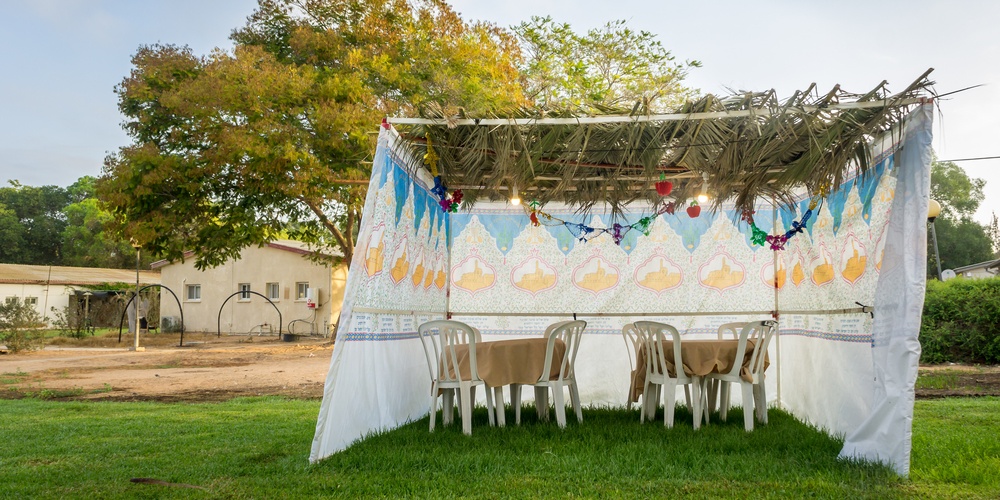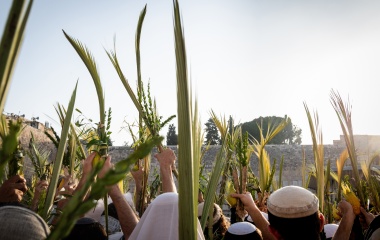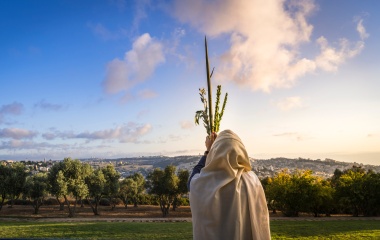
For seven days a year, one is to “make his home temporary and his Sukkah permanent”. Ideally, we move our finest furniture, china, and even our bedroom set into the Sukkah, our “fall home”. While our modern-day living habits make much of this extremely impractical, the Sukkah is meant to be our home for the week.
Yet while we spend much effort beautifying our Sukkah, the actual construction of a Sukkah requires far less than any home renovation might. Strangely, a Sukkah does not even need to be enclosed, a structure of two and half walls being sufficient for a Sukkah. These walls don't even have to be solid, as a few narrow poles a foot or so apart count as a valid wall[1]. In fact, one does not even need walls at all. An obscure Talmudic principle, gud aseek mechitza, allows one to build a Sukkah directly on top of one's house by putting poles on the corner of house, with the walls of the house symbolically extending above the roof to serve as the Sukkah “walls”. The Sukkah itself can be so small that even if one cannot fully fit inside the Sukkah, it remains valid, provided a “majority of one's head, body, and [a] table” can fit inside.
The contrast to the taking of the four species, the other featured mitzvah of Sukkot, could not be more striking. Here, the slightest imperfection invalidates the lulav and etrog. A split leaf, a broken pitam, or a slight discoloration are some of the many things we must be on the watch for, lest our mitzvah be invalidated.
Why are we so strict with our little lulav and etrog when the Sukkah itself has so many leniencies?
"And on the first day, you shall take for yourselves an etrog, fruit of the citron tree, a lulav, an unopened palm frond, hadas, myrtle branches, and aravot, willows" (Vayikra 23:40). Jewish law demands that one must actually own one's own set of the four species, the arba minim. The taking of the arba minim is a recognition that our material blessings, notwithstanding our own hard work and smarts, are Divine blessings. Each one of us personally must display our personal gratitude for our blessings. When it comes to our own personal observance, one must be most meticulous. We must strive to eliminate any imperfection in ourselves. We must be hadar, beautiful, and even a small missing piece takes away so much potential beauty.
The building of the Sukkah, on the other hand, testifies to the ongoing historical relationship between G-d and the Jewish people, not as individuals but as a collective. “All of Israel shall dwell in the Sukkah” (Vayikra 23:42). As we enter the Sukkah, our focus must change. When dealing with other Jews, we must have a much more tolerant attitude, accepting their flaws and embracing even (especially?) those who have yet to build a meaningful Jewish life. All must be welcomed under the canopy of Jewish life.
While the arba minim may have a high standard of kashrut, the arba minim themselves represent different types of Jews, ranging from the pious and learned to the apathetic and ignorant. The arava, representing the Jew without learning or mitzvot, is in fact kosher if even only one leaf remains. In proximity to the etrog, even those who are far removed can be part of our tradition.
These two themes of Sukkot, the need for self-improvement coupled with an openness to all Jews, are in reality a continuation of the themes of Yom Kippur. On the one hand, Yom Kippur is a day for personal reflection, repentance, and growth, as we resolve not to repeat the mistakes of the past. Our attempt must be such that the “Master of the universe will testify that we shall not return to this sin”. Nothing less than perfection is called for.
Yet at the same time, Yom Kippur is the day by which we must appease our neighbour. We begin Kol Nidrei by welcoming sinners to join us in the synagogue. It is the day on which the Torah was given anew, a re-creation of Sinai where we stood “like one person with one heart”. All Jews must be part of the Sinai experience. It is the proper combination of striving for perfection without losing the ability to accept others that makes Sukkot zman simchateinu, the time of our joy. May we merit both personal and communal joy.
[1] Unfortunately, this year these halachot are most useful allowing us to build a more open and hence safer sukkah. Needless to say, one should only consider having guests in rare circumstances and only with proper social distancing.



